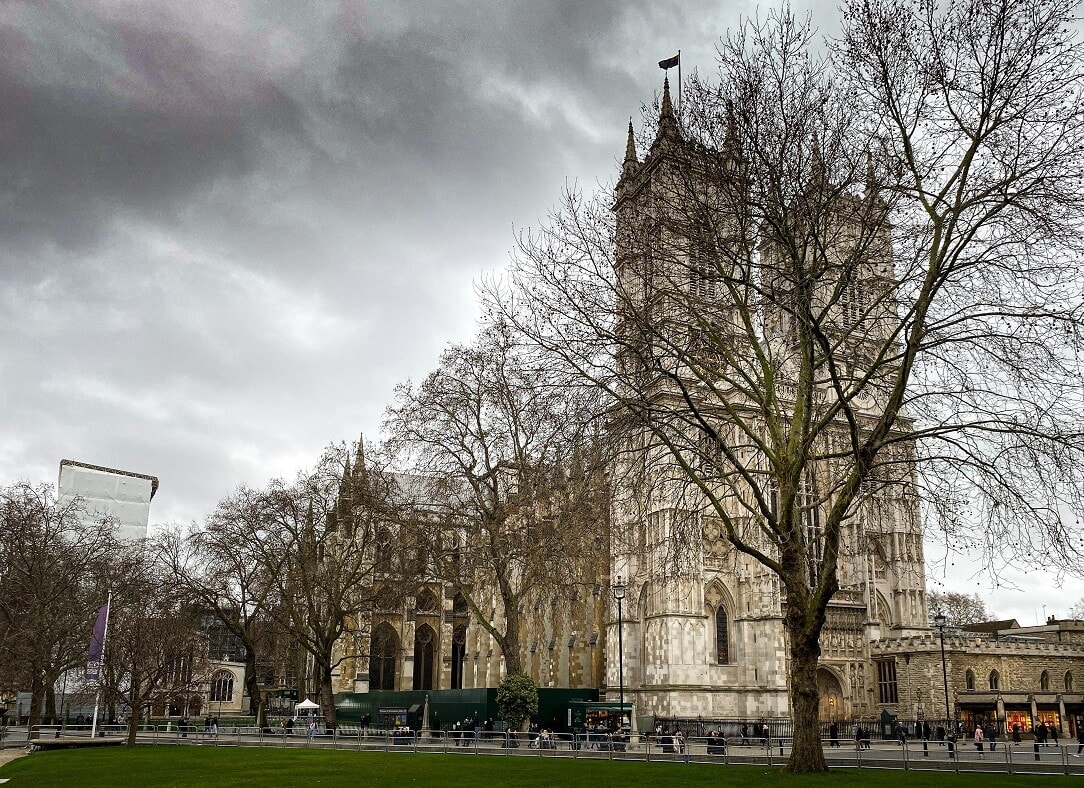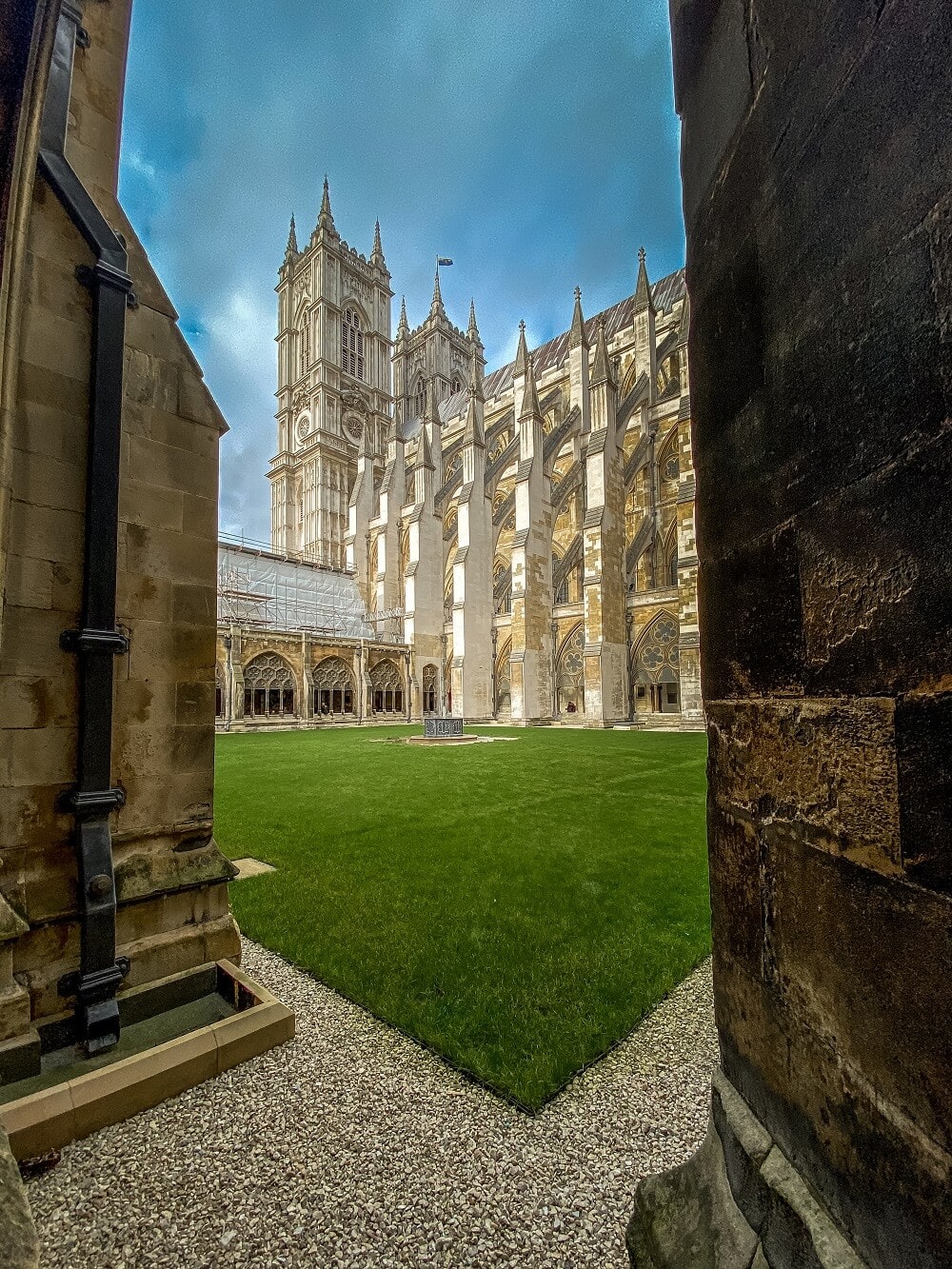I visited Westminster Abbey for the first time when I was a teenager. While I still remember my visit, I wanted to go to the Abbey again now that I have learned a bit more about British history.
It’s a UNESCO Heritage site and one of those places that you shouldn’t miss when visiting London. Westminster Abbey is a working church with strong ties to the Royal family and British Government. The building is an example of medieval perpendicular gothic architecture at its finest.
There are a lot of things to see at Westminster Abbey so I have created this guide to help you plan your visit. Learn more about its history, the highlights that you shouldn’t miss, and get some important tips to make the most of your time at the Abbey.
Note: This post contains affiliate links. Please see disclosure for more information.
If you can’t visit Westminster Abbey in person, you can download the audio tour app, which also includes pictures, or listen to the podcast that features readings, short addresses, anthems, prayers, blessings, and music from the Westminster Choir. Read about more virtual London tours here.
Contents
- The History of Westminster Abbey
- What to See at Westminster Abbey
- Entry (North Transept)
- North Choir Aisle
- Tomb of the Unknown Warrior
- Nave
- Quire
- High Altar
- North Ambulatory Chapels
- Shrine of St. Edward the Confessor
- Tomb of Elizabeth I and Mary I
- The Lady Chapel
- RAF Chapel
- Tomb of Mary Queen of Scots
- South Ambulatory Aisle
- Poets’ Corner
- Queen’s Diamond Jubilee Galleries
- Cloisters
- Pyx Chamber
- Chapter House
- Coronation Chair
- Americans in Westminster Abbey
- Westminster Abbey Shop
- Where to Eat at Westminster Abbey
- Where to Get the Best Photos of Westminster Abbey
- Westminster Abbey Hours
- Westminster Abbey Admission
- How to Save on Westminster Abbey Admission
- How to visit Westminster Abbey for free
- How to Get to Westminster Abbey
- Things to Know Before Visiting Westminster Abbey
- Is Westminster Abbey Accessible?
- How Long Does it Take to Visit Westminster Abbey?
- Is Westminster Abbey Good for Kids?
- Should You Do a Guided Tour of Westminster Abbey?
- Other Tourist Attractions Near Westminster Abbey
- Is Visiting Westminster Abbey Worth it?
- Expert Tips for Visiting Westminster Abbey
The History of Westminster Abbey
The site has been a place of worship for over 1,000 years. Benedictine monks founded Westminster Abbey in 960 (although there were churches on the site at least since the 7th century). Since 1066, every English and then British coronation has taken place at the Abbey and it is the final resting place for monarchs, poets, musicians, scientists, and politicians. It has also been the venue for 16 royal weddings.
The church built by Edward the Confessor in the 11th century was constructed in the Romanesque style. It was the first in England to be shaped like a cross. Only some areas from the lower part of the monastic dormitory still remain.
In the 13th century, Henry III ordered a new more elaborate church to be built with the shrine of Edward the Confessor at its heart. This is the building we see today. You will notice typical gothic architectural features like pointed arches, ribbed vaulting, flying buttresses, and rose windows. The Rose window above entrance is from 1722 and depicts apostles excluding Judas. The opposite rose window is from 1902 and depicts a variety of figures.
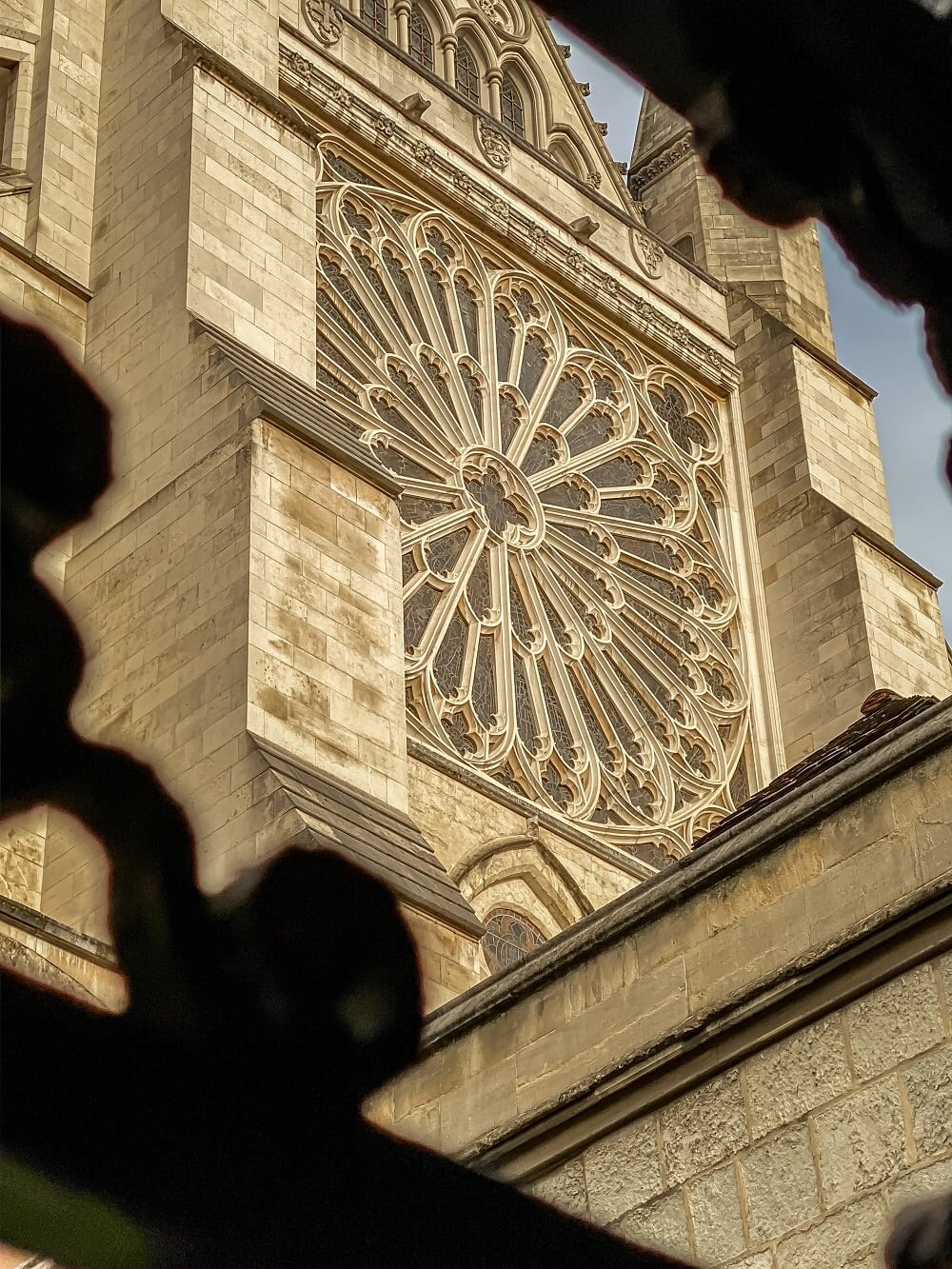
Henry VII added the Lady Chapel dedicated to the Virgin Mary. In the 16th century, Henry VIII granted the Abbey cathedral status to spare it from the destruction that most English abbeys faced during the Dissolution of the Monasteries.
Elizabeth I gave the Abbey its formal title – the Collegiate Church of St Peter. It is not part of the reporting hierarchy within the Church of England and instead, reports directly to the sovereign rather than the Archbishop of Canterbury.
The Abbey was damaged by Puritans during the 17th century but was again protected by its close ties to the government. The two western towers were added in the 18th century.
Westminster Abbey was damaged during World War II, but luckily many treasures were sent away to be hidden when the war started. The Abbey suffered minor damage during the Blitz in 1940. In 1941, the roof was hit by several bombs that started a fire. The burning timbers and molten lead fell into the open area below where the fire could be more easily extinguished.
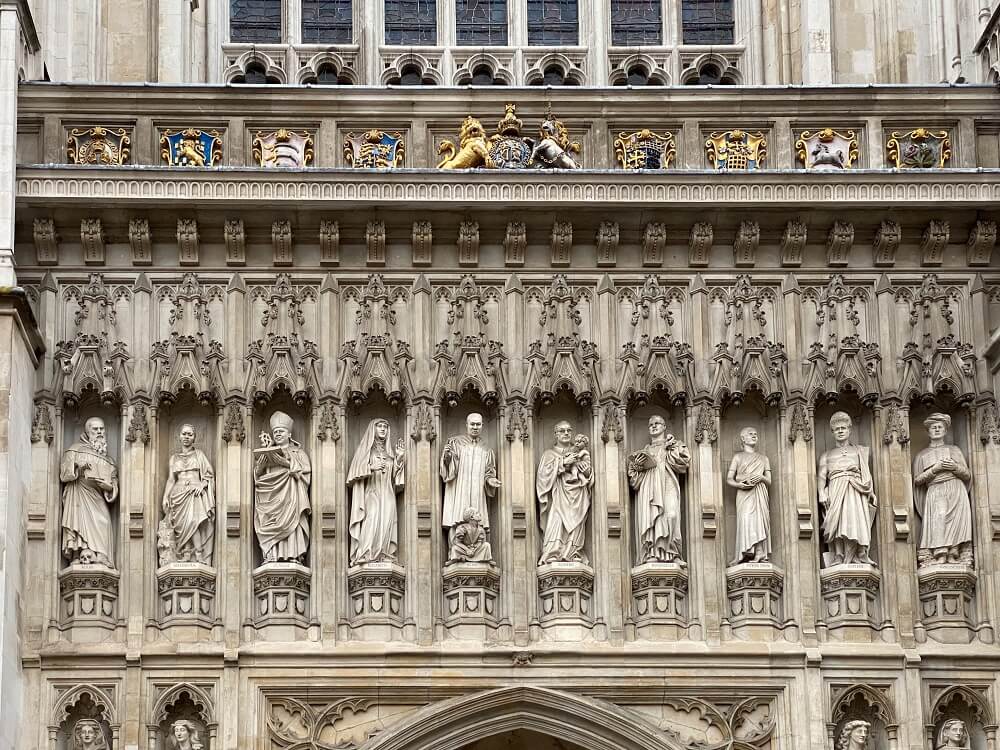
Most recently, in 1998, ten statues of modern martyrs were added in the niches over the West Door which had previously been empty. The modern martyrs are Dr. Martin Luther King Jr, St Oscar Romero, Dietrich Bonhoeffer, Wang Zhiming, St Maximilian Kolbe, Manche Masemola, Esther John, Janani Luwum, Lucian Tapiedi, and Grand Duchess Elizabeth. In 2018, Westminster Abbey was featured in London Lumiere.
It is also the site of some state funerals including the one for Queen Elizabeth II on September 19, 2022.
Please be conscious of the historical nature of the building. Do not lean on or touch any of the monuments.
What to See at Westminster Abbey
Even though it was my second visit to Westminster Abbey I was surprised by how much there is to see. There are over 3,000 people buried in Westminster Abbey! That’s not all. There are historical artifacts and interesting architecture that you don’t want to miss.
I want to manage your expectations – you will not be able to see everything in one visit. Let me help you prioritize and tell you the most important things to see when visiting Westminster Abbey.
Entry (North Transept)
The history starts the second you walk in the door. Before your audio tour starts you will see several important figures in British history. It shows that there is a strong link between the Abbey and the government.
There are larger-than-life statues to honor some of the leading Prime Ministers from the 18th and 19th centuries including Viscount Patterson, Robert Peel, Benjamin Disraeli, and William Gladstone (who is buried nearby). It is a bit ironic that the tributes to Disraeli and Gladstone are so close together when they were bitter rivals.
The largest memorial in this area is dedicated to Prime Minister William Pitt. He is buried nearby with his son William Pitt the Younger. There is a plaque honoring the younger near the west door.
Also if you take a minute to admire the stained glass here you will notice that there is one panel that is modern. The window pays tribute to the Queen and depicts a hawthorn blossom scene in Yorkshire. It was designed by David Hockney and installed in 2018.
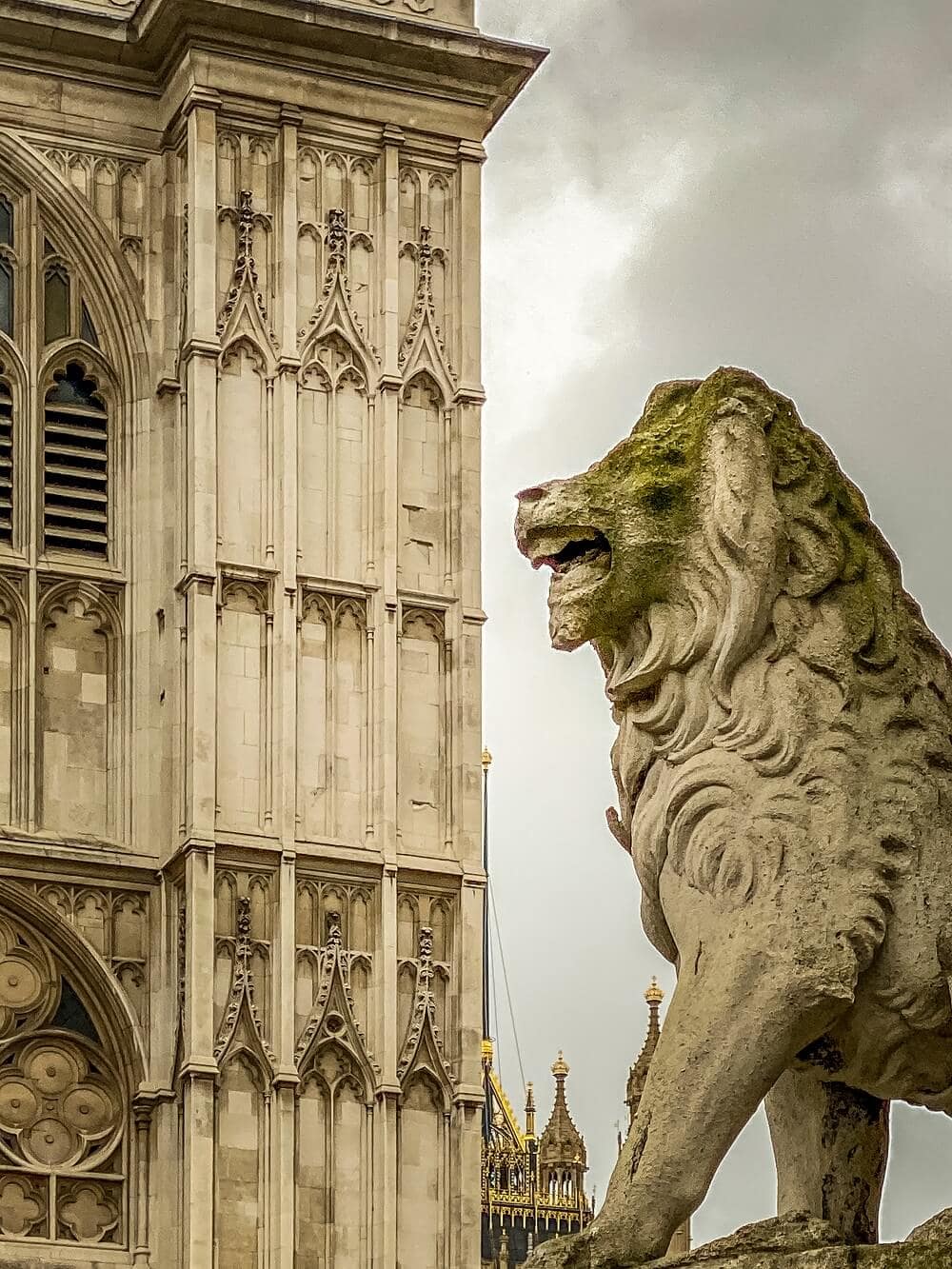
North Choir Aisle
This is where the audio tour starts but it doesn’t mention what to see on this aisle. We enjoyed looking at the plaques and statues. We found a few interesting ones:
- William Wilberforce: As a member of Parliament (and close friend of William Pitt), he took up the cause for the abolition of slavery. The Abolition Bill became law in 1807, long before slavery was outlawed in the US.
- Charles Darwin: It’s a bit ironic that Charles Darwin is buried in a religious building given that he introduced the theory of evolution, but fitting that he is near his fellow scientists. (Isaac Newton and others are in the Nave on the other side of the rope).
- Musicians: Music is integral to the Abbey, so it is fitting there is an area where several musicians and composers including Henry Purcell, Ralph Vaughan Williams, John Robinson, and William Sterndale Bennett are remembered.
Tomb of the Unknown Warrior
The Tomb of the Unknown Warrior can be found at the back of the nave. It is the tomb of a British soldier brought back from France and buried in Westminster Abbey on Armistice Day in 1920. The grave is appropriately framed with poppies, a symbol of both Remembrance and hope for a peaceful future. This is the only grave in the Abbey that is never walked on.
Don’t miss the framed document on the pillar to the north of the grave. It contains the Congressional Medal of Honor that General Pershing awarded to the Unknown Warrior on October 17, 1921, on behalf of the USA. The Congressional Medal of Honor Society’s flag, presented to the Unknown Warrior in October 2013, is also on the pillar.

When the Duke of York (later King George VI) married Lady Elizabeth Bowes Lyon in the Abbey in 1923 she laid her wedding bouquet on the grave as a mark of respect. She had lost a brother during the war. All royal brides married in the Abbey since then have sent back their bouquets to be laid on the grave. Some royal brides who were married elsewhere have done the same.
Near the tomb of the Unknown Warrior is a plaque to honor Prime Minister Winston Churchill. It was unveiled by Queen Elizabeth II on 19th September 1965, the 25th anniversary of the Battle of Britain, and a wreath was laid by his widow. He is buried near Blenheim Palace in Oxfordshire with other family members.
The nave is the main public part of the Abbey. This is where commoners would most likely sit at a service. While you are in the nave take time to admire the medieval ceiling and chandeliers.
As you walk around the area, you will notice several important people commemorated here:
- John Harrison, the clockmaker, has a memorial with a meridian line engraved with its own longitude of 0 degrees, 7 minutes and 35 seconds West in two metals to highlight Harrison’s most widespread invention, the bimetallic strip thermometer.
- David Livingstone, a Scottish physician, Congregationalist, explorer in Africa, and one of the most popular British heroes of the late 19th-century Victorian era is buried here.
- Nelson Mandela, the South African anti-apartheid revolutionary, political leader, and President of South Africa has a memorial stone inscribed with the words “Forgiveness Reconciliation.”
The Nave also has an area called Scientists’ Corner. Sir Isaac Newton’s elaborate and imposing tomb is on the left side of the nave just before you go to the Quire. Several other important figures in science are memorialized nearby. The latest addition to Scientists’ Corner is Stephen Hawking who died in 2018. His plaque has a picture of a black hole and bears the inscription “Here lies what was mortal of Stephen Hawking”. This is the English translation of the words on Newton’s tomb which says the same thing but in Latin.
Quire
The Quire area is where the monks would sit for daily prayers. Now, it is used for the Westminster Choir and clergy. The Choir of Westminster Cathedral was founded in 1901 and is known as one of the finest in the world.
The Quire stalls you see today were installed in 1848. Stalls not used by the Choir are assigned to the Monarch, clergy, officers of the Abbey, and High Commissioners for the Commonwealth countries when they attend services. Some have nameplates.
High Altar
The High Altar is the place where the Eucharist is celebrated. There are four services each day. They change the color and the types of flowers on the altar for the seasons.
The Cosmati Pavement in front of the altar was laid in 1268 by craftsmen from Rome under the order of Henry III. It is made of colored glass and marble and was restored in 2010. The Monarch is crowned here during the coronation ceremony.
North Ambulatory Chapels
These chapels contain some elaborate tombs with intricate carvings, but we had a difficult time figuring out who was who. When we were able to find names, we didn’t recognize them. If you are tight on time, you can go through this section quickly.
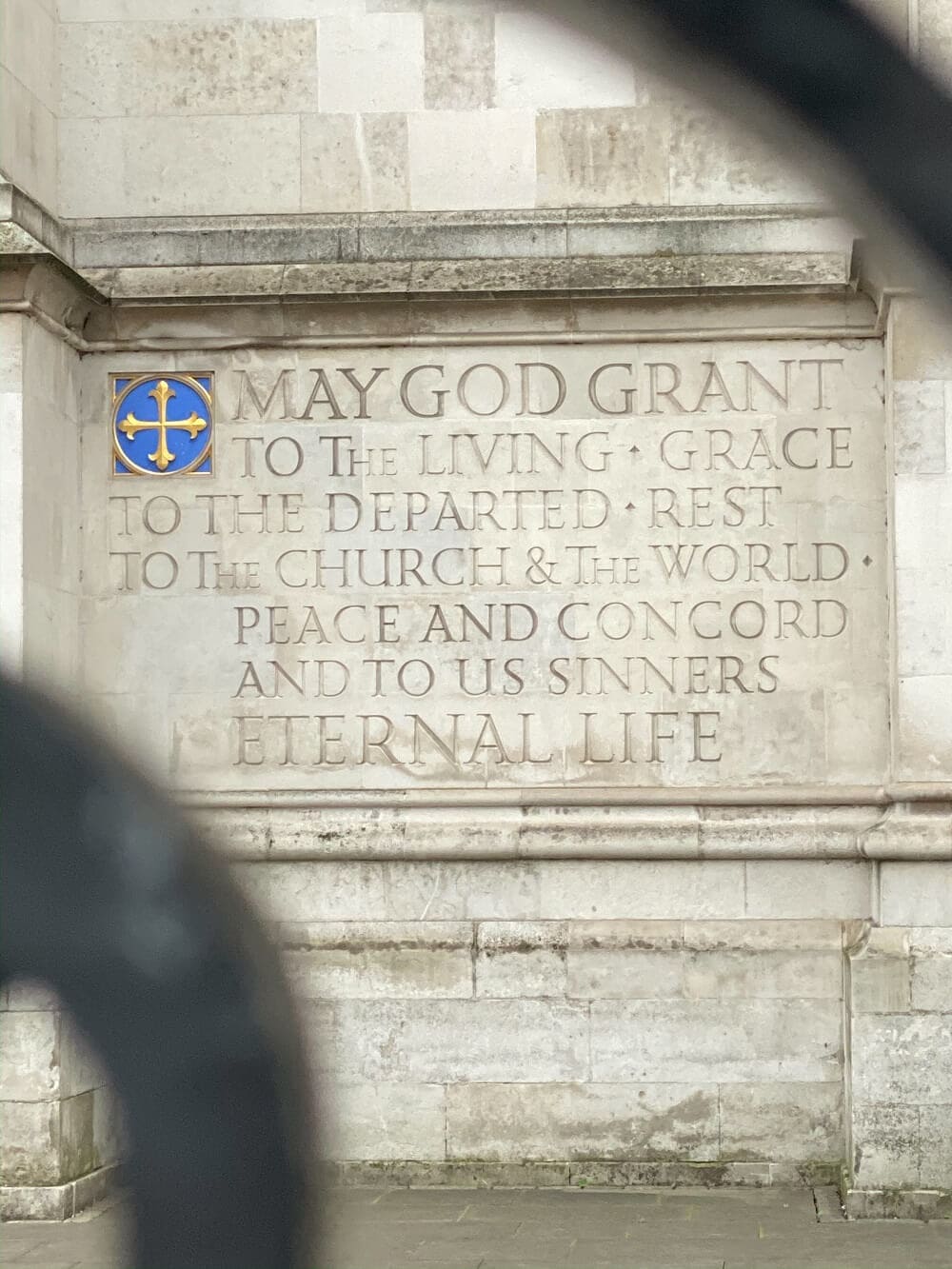
Shrine of St. Edward the Confessor
Behind the high altar is the shrine of Edward the Confessor. The shrine is considered the center of the Abbey and five kings (including Henry III, Edward III, and Henry V) and four queens are now buried in this area. The floor is extremely fragile so only those here for private prayer or the guided tour can actually enter the Shrine. You can try to peak through the stairs or get a view from above in the Queen’s Gallery.
Edward died in 1066 and was buried in the Abbey. In 1163, he was moved to a special shrine. Then in 1269, he was moved to a more elaborate shrine created by Henry III. During the Dissolution of the Monasteries, Edward’s tomb was moved and robbed of its jewels. When Mary I took the throne she repaired the Shrine, moved the coffin back to its place, and gave jewels to replace the ones that were stolen.
Tomb of Elizabeth I and Mary I
In this narrow room with an ornate fanned ceiling, you will find the tomb of Elizabeth I and Mary I. I found it ironic they were buried together as sisters as they did not get along. The figure on top of the tomb is clearly Elizabeth and there is barely a mention of Mary.
While both are the daughters of Henry VIII, Mary’s mother, Catherine of Aragon, was Catholic, and Elizabeth’s mother, Anne Boleyn, was Protestant. Mary is also known as Bloody Mary because she had many Protestants killed.
Innocents’ Corner in the back of the contains a sarcophagus for the remains of two princes who are known today as The Princes in the Tower. Princes Edward and Richard were the only sons of King Edward IV, and are usually assumed to have been murdered in the Tower of London to allow their uncle, Richard III, to claim the throne.
The Lady Chapel
The Lady Chapel is like its own church. It has a nave, quire, font, and altar. It was built by Henry VII and is one of the best examples of late-medieval English architecture. The roof and walls are intricate, with delicate carvings, almost more like glass than stone.
Behind the altar, you will find the tomb of Henry VII and his queen. Key members of his family are buried around him. Members of the Stuart dynasty, including Charles II, are buried in a vault under the floor. Henry VIII is the only Tudor monarch who is not buried at Westminster Abbey. Instead, his final resting place is at Windsor Castle with his favorite wife, Jane Seymour.
RAF Chapel
In the back of the Lady Chapel behind the tomb of Henry VII, there is the RAF chapel which is dedicated to the men of the Royal Air Force who died in the Battle of Britain in 1940. A hole in the stonework has been covered in glass as a reminder of when the Abbey was hit by bombs in 1940. The stained glass shows the badges of the squadrons that fought including those from the US, Canada, Poland, and the former Czechoslovakia.
On the floor, there is a plaque noting the temporary burial place of Oliver Cromwell. His body was removed when Charles II took the throne. Cromwell’s head was cut off and place on a spike outside Westminster Hall.
Tomb of Mary Queen of Scots
The room across the church from where Elizabeth I is buried houses the tomb of her cousin, Mary Queen of Scots. After Elizabeth I ordered her execution, Mary was originally buried in Peterborough Cathedral. When her son James, became James I of England/VI of Scotland, he had her body moved to Westminster Abbey. He made sure her tomb was even bigger than Elizabeth’s. It is decorated with symbols of the three countries where Mary laid claim to the throne – England, Scotland, and France.
Lady Margaret Beaufort, who was the mother of King Henry VII, and Margaret Douglas, who was Mary Queen of Scots’s mother-in-law are also buried in this room. Margaret Douglas was the mother of Mary’s husband, Lord Darnley, who was the father of James I/VI.
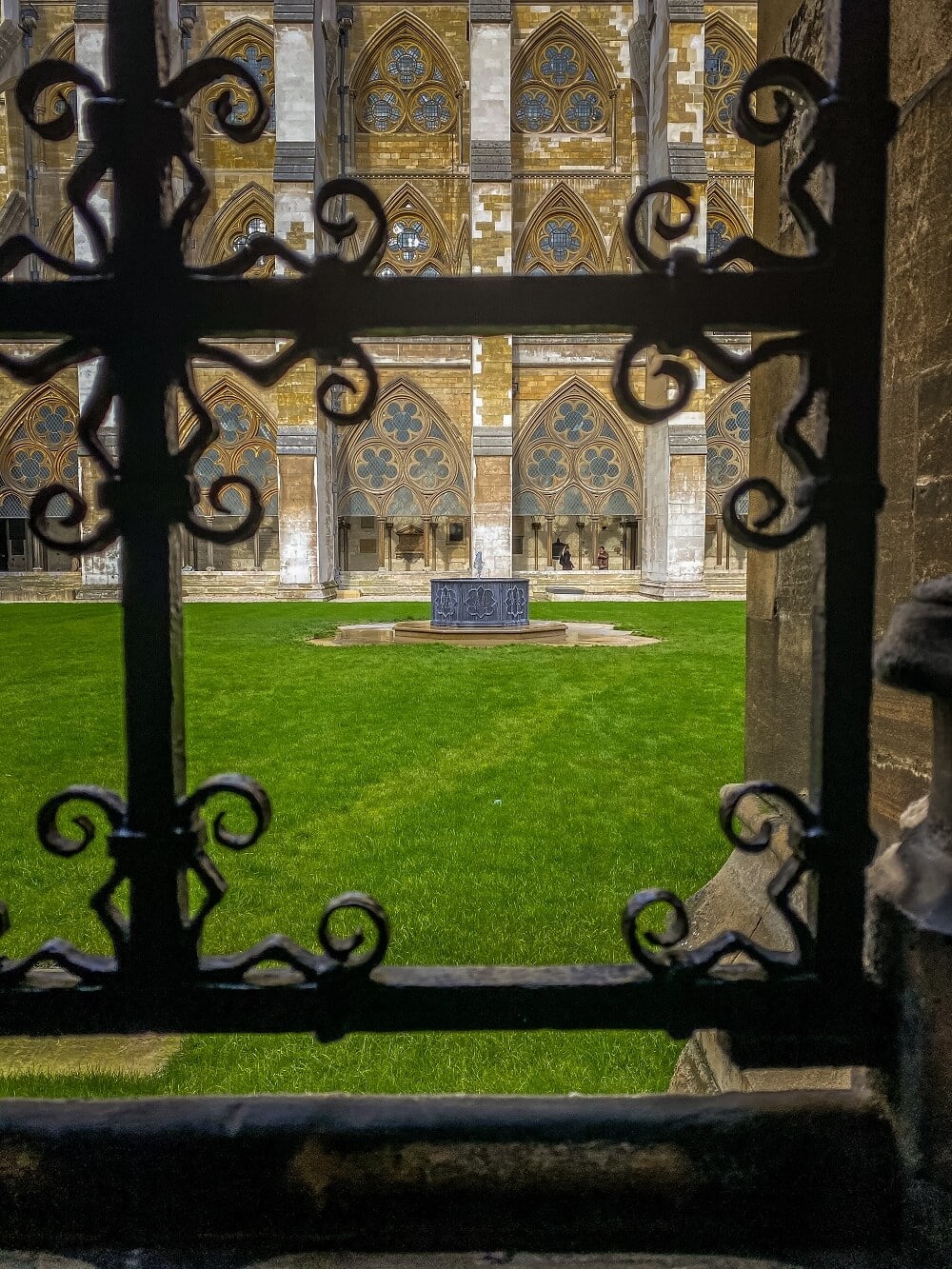
South Ambulatory Aisle
The small chapels off the aisle contain more ornate tombs. In this area, there are memorials to two Queens, Anne Neville (the wife of Richard III) and Anne of Cleeves (Henry VIII’s 4th wife). Additionally, many members of the Percy family, who own Alnwick Castle, are buried here.
Poets’ Corner
I was surprised by the number of people that are memorialized in Poets’ Corner. Geoffrey Chaucer was the first person buried in this part of the Abbey. Then, Edmond Spencer wanted to be buried near Chaucer and Poets’ Corner was born.
Some of the other famous writers commemorated in Poets’ Corner are William Shakespeare, Robert Browning, Lord Bryon, Alfred Lord Tennyson, Lewis Carroll, CS Lewis, Charles Dickens, Rudyard Kipling, Thomas Hardy. and Jane Austen. Not all these legends are buried in Westminster Abbey, for example, Jane Austen is buried in Winchester Cathedral. In addition to the famous writers, there was also a plaque for Laurence Olivier, the actor, and one dedicated to the war poets.
Queen’s Diamond Jubilee Galleries
At the back of Poets’ Corner, you will find the entrance to the Queen’s Galleries which opened in 2018. Here you will find over 300 objects chosen by the Queen from the Abbey’s collection.
We debated about skipping the galleries as we were a bit tight on time. I am glad we didn’t. It might have been my favorite part of the visit. There is an additional charge of £5 per person and you can buy the tickets at the entrance to the galleries.
When you enter the galleries, you will be given a brochure that includes a map and some of the highlights. Use the brochure as a guide, but try to browse and see items not listed too. We were amazed at some of the things we saw like:
- Copy of the Magna Carta – One of 24 surviving copies from 1300. The original copy we saw in Salisbury Cathedral was from 1215.
- Replicas of the Crown Jewels – The real Crown Jewels are kept under extremely tight security in the Tower of London, these replicas are used for rehearsals.
- The Coronation Chair of Mary II – Since Mary ruled jointly with William they needed an extra coronation chair. You see the coronation chair that has been used for all the other Monarchs for about the last 1,000 years by the exit of the Abbey.
- Funeral Effigies of several Monarchs and other important figures including King Edward III, Queen Mary I, King Charles II, King William III, Queen Mary II, Queen Anne, and the head of King Henry VII.
- Retable – The 13th century Westminster Retable is England’s oldest altarpiece.
- Litlyngton Missal – A lavish manuscript used for prayers at the high altar. It reminded me of the Book of Kells.
- Marriage License of Prince William and Catherine Middleton – This document is a piece of art! It was exciting to see something so important and personal to the Duke and Duchess of Cambridge.
In addition to the treasures on display, I enjoyed getting the view of the abbey from above. I could imagine all the people gathering for a coronation or royal wedding. From the Queen’s Gallery, I was also able to get an aerial view of Edward the Confessor’s Shrine.
Cloisters
The Cloisters used to be the center of monastic life. The most important buildings of the monastery were organized around it. There are actually two cloisters at Westminster Abbey. I think a lot of people (like us) miss the Little Cloisters as there is no sign directing you to walk to it. It’s down the gated walkway just past the Pyx Chamber.
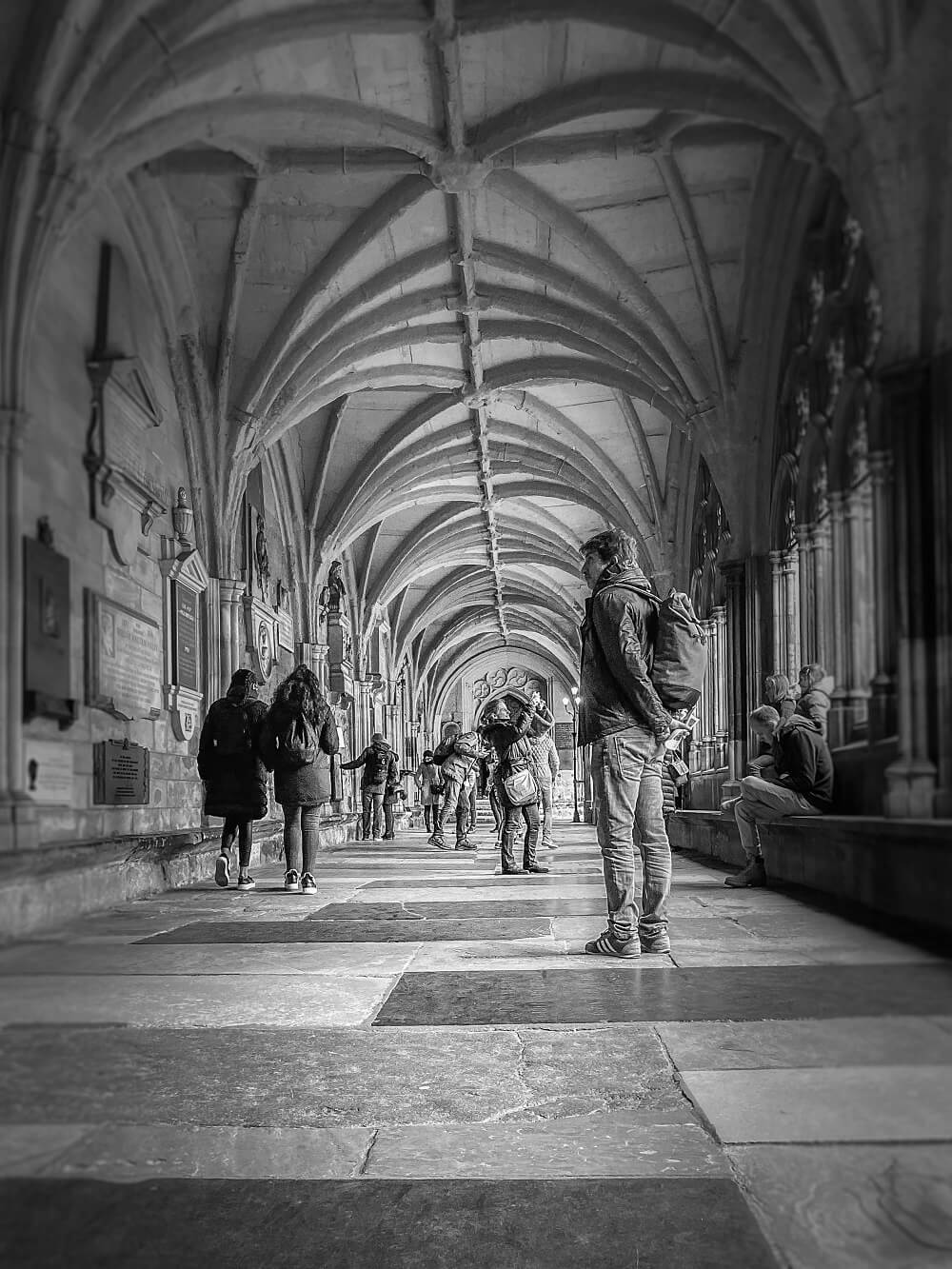
The infirmary was in the Little Cloister. They grew medicinal herbs in the nearby garden. Today some of the Abbey Clergy live here. There is a doorway you can look through and see the ruins of Chapel St. Catherine and Victoria Tower at the southern end of the Palace of Westminster.
If you visit Tuesday, Wednesday, or Thursday, the gardens are also open to the public. Our visit was on a Saturday, so we couldn’t go to the gardens.
Pyx Chamber
The Pyx Chamber is one of the oldest parts of Westminster Abbey. It was built in the late 11th century. Originally it was the undercroft below the monk’s dormitory. During later years it became a storage room for valuables because it had thick walls, iron window bars, and six locks on the door.
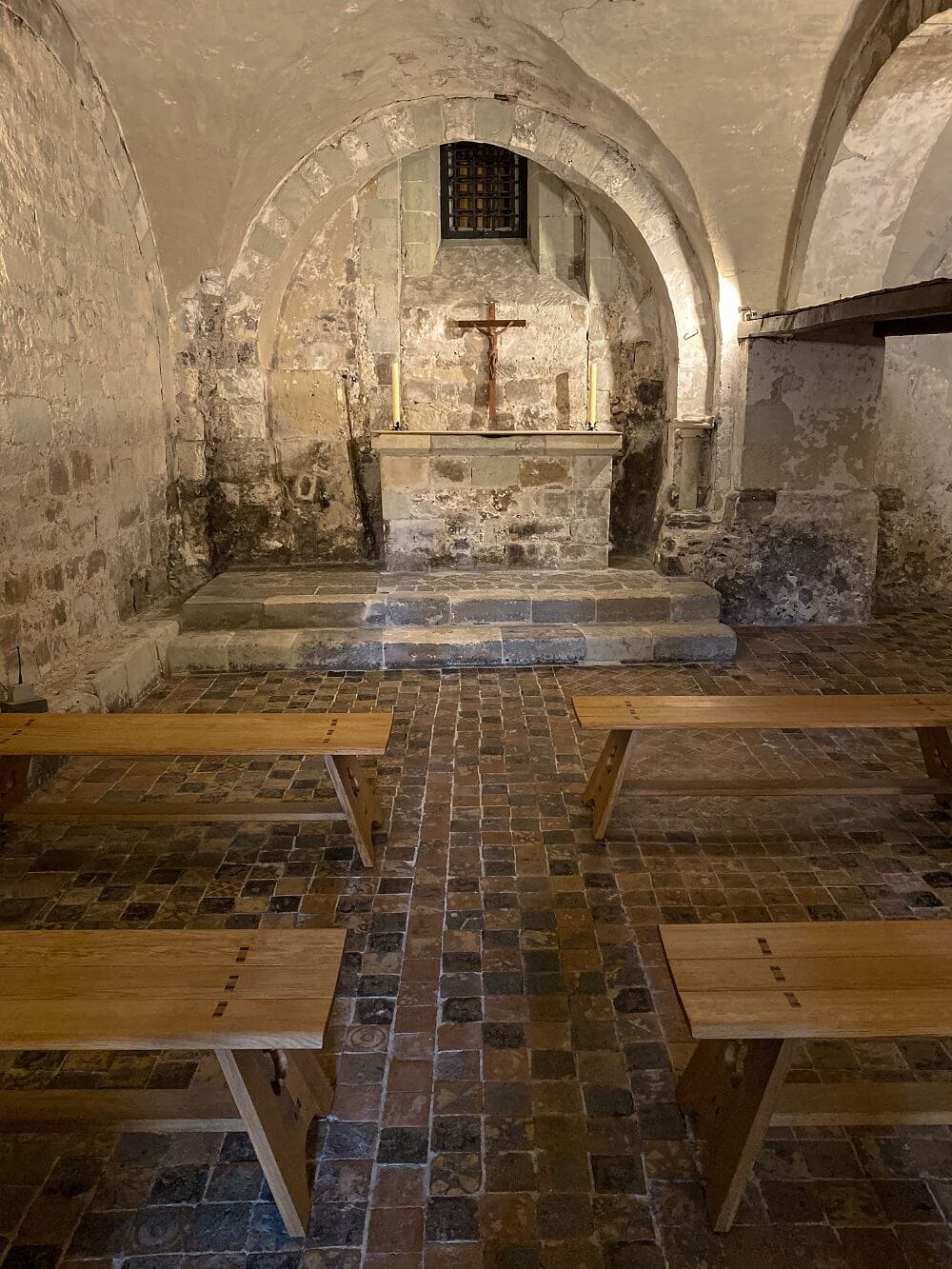
The name “Pyx” came from the small boxes where official samples of gold and silver coins were kept. New coins were tested annually in a public “Trail of the Pyx” at the Palace of Westminster.
Chapter House
Don’t miss the Chapter House. It was built in the mid-13th century on the orders of Henry III and has some of my favorite architecture and artwork in the Abbey. The walkway into the Chapter House reminded me of the cellarium at Fountains Abbey in Yorkshire.
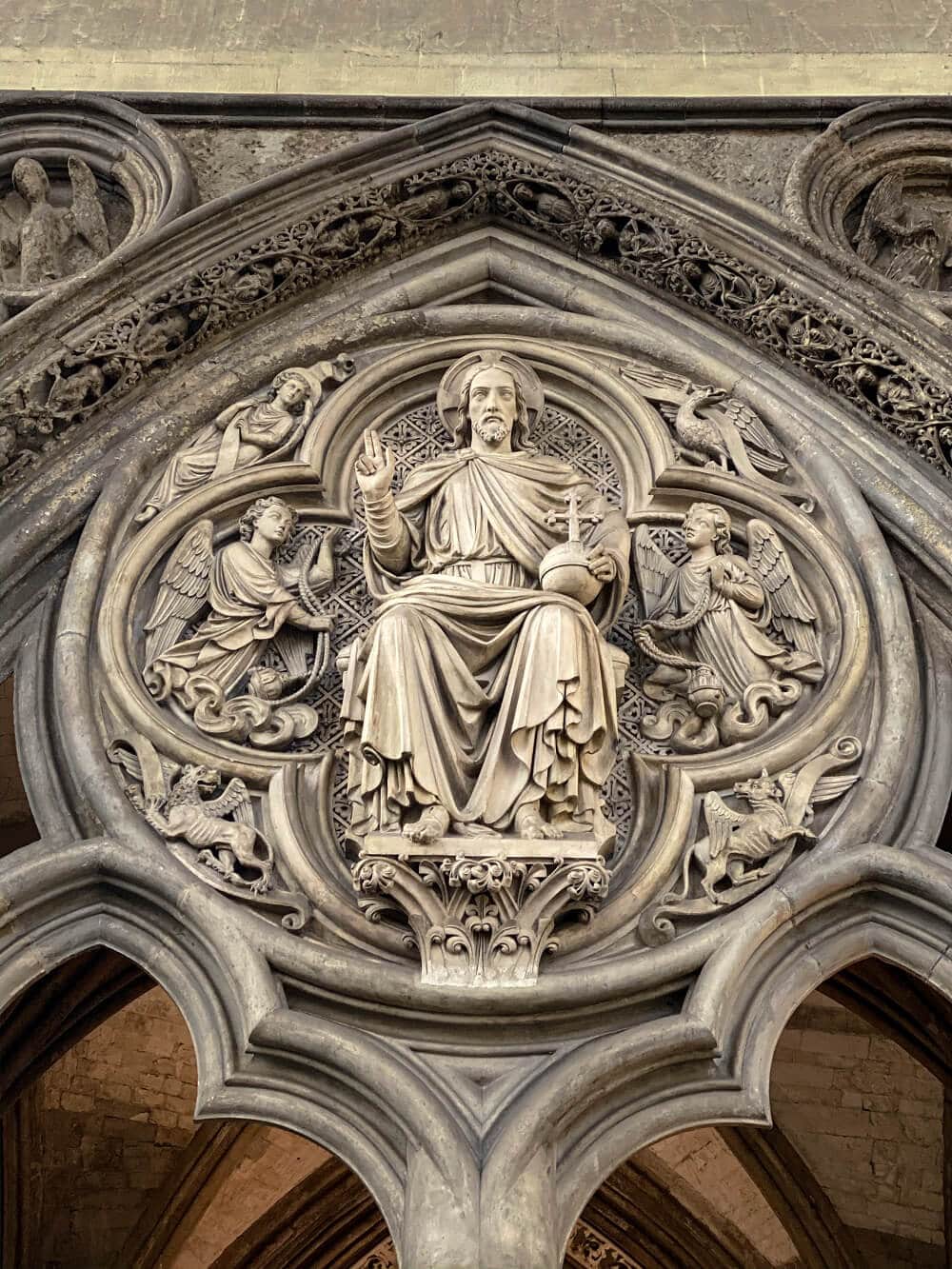
When you enter the Chapter House, turn around and look at the medieval sculptures above the doorway. These include the Archangel Gabriel, Christ in Majesty, and Mary. The Christ sculpture was actually added in Victorian times. These all used to be brightly painted. There is more beautiful stonework in the ceiling.
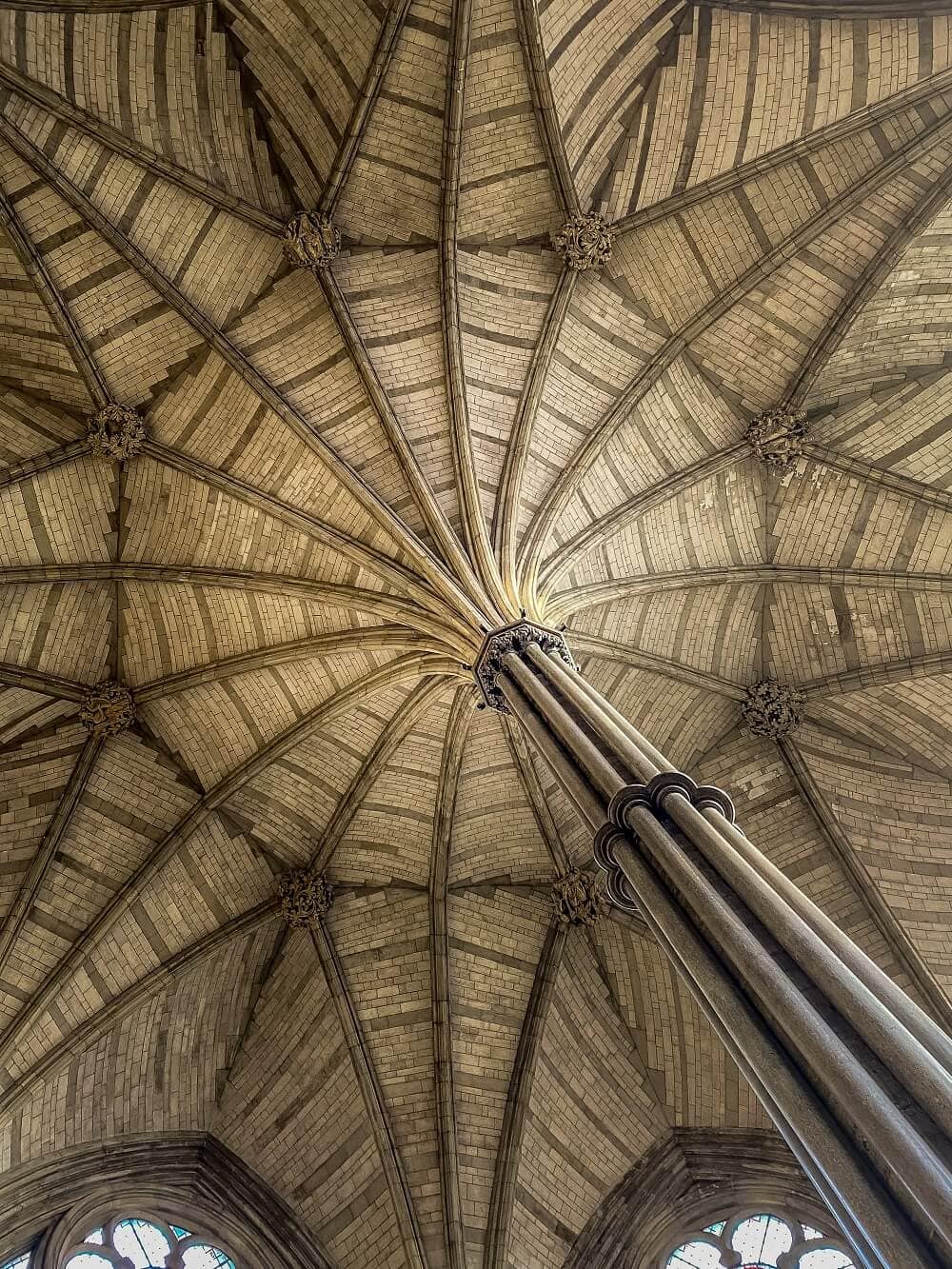
Stained glass windows surround you in the Chapter House. The original 13th-century glass was lost by the 18th century. Now, looking at the glass it’s hard to tell it was also destroyed during World War II. They tried to use as much of the Victorian glass as they could in the new panels, which include coats of arms from people associated with the Chapter House over the years. The southwest window has tiny images related to World War II.
The paintings on the walls around the room aren’t in the best condition, but you can still imagine what it would have looked like in its prime. The stone benches are where the monks would sit during their daily meetings. During the Dissolution of the Monasteries, they used the Chapter House for Parliamentary meetings and to store state documents.
The medieval floor tiles in the center of the room are worth a look. They are made by stamping designs in clay, filling in the impressions with a lighter clay, and then glazing. The glaze has worn away. The patterns in the tiles include Henry III’s coat of arms, people, fish, animals, geometric shapes, and a rose window similar to the one in the Abbey.
Coronation Chair
The Coronation Chair is on display just before you leave Westminster Abbey. Unfortunately, you can’t get too close to it, but that is understandable given its age and significance. While coronations have taken place at the Abbey since 1066, the chair has only been used for the last 700 years.
King Edward I had the Coronation Chair made to enclose the famous Stone of Scone, also known as the Stone of Destiny, which he brought from Scotland to the Abbey in 1296. Now, the Stone of Scone is on display along with the Crown Jewels in Edinburgh Castle but will be returned to Westminster Abbey for future coronations.
Americans in Westminster Abbey
Westminster Abbey is not just a place to commemorate important British legends. There are people from across the globe that are honored here. Even a few Americans! While I didn’t find any Americans buried in Westminster Abbey, I did find these tributes:
- Henry Wadsworth Longfellow – In Poets’ Corner, there is a sculpture to honor the American poet, who is buried in Massachusetts.
- George Peabody – The American philanthropist was originally buried in Westminster Abbey but later moved back to Massachusetts. Look for a plaque in the nave.
- Franklin D. Roosevelt – As you leave the Abbey, there is a large plaque just to the left of the door for FDR, the 32nd President of the United States, calling him “a faithful friend of freedom and of Britain.”
- Martin Luther King Jr. – MLK, the civil rights leader, was added as one of the 10 modern martyrs about the West Door in 1998.
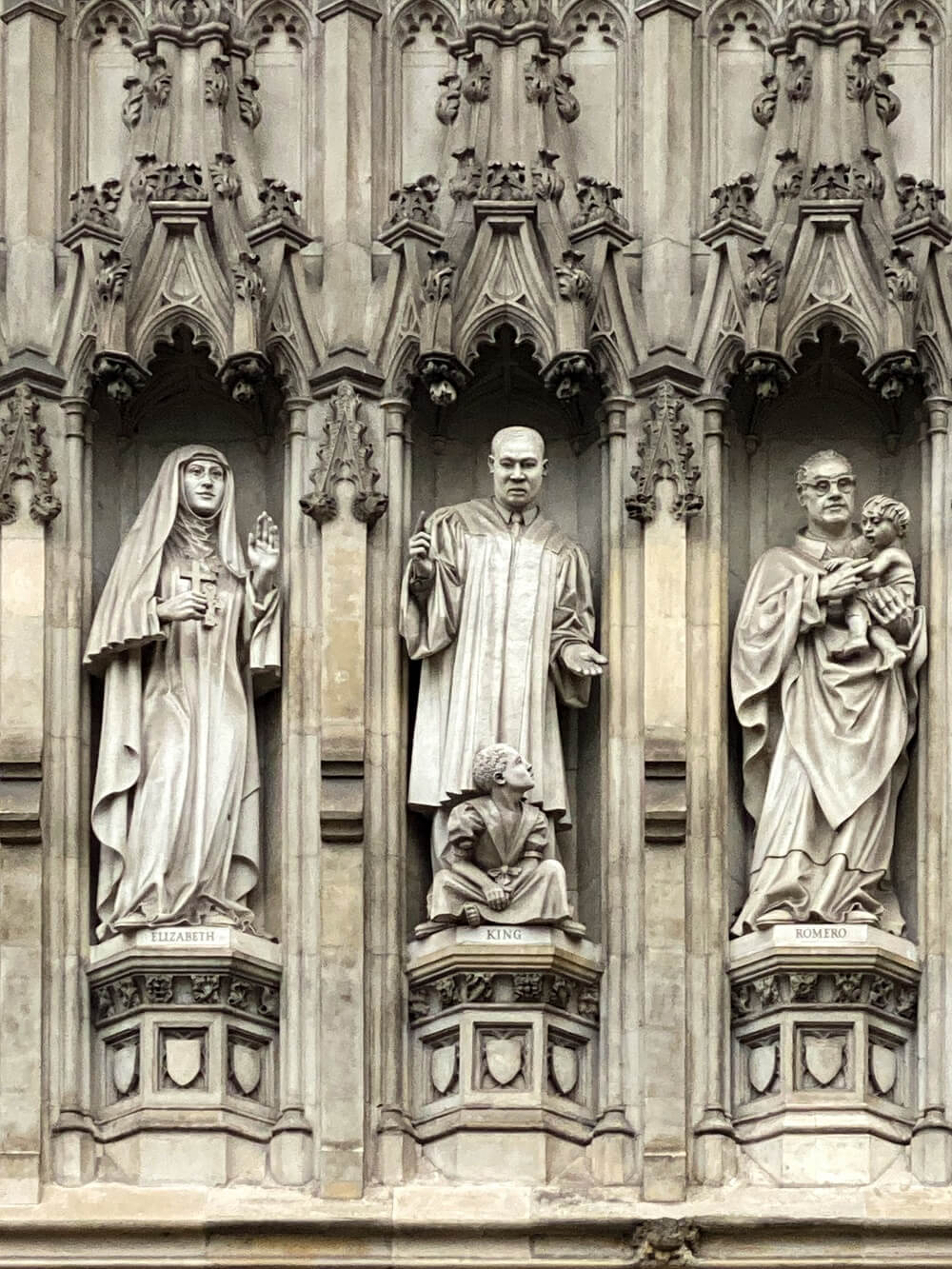
Westminster Abbey Shop
After you exit the abbey, the gift shop will be on your left. It has plenty of London souvenirs and some books that will teach you more about Westminster Abbey.
Where to Eat at Westminster Abbey
Right off the cloisters is the Cellarium. It used to be a storage area for the monks, but it has been converted into a cafe. The cafe serves meals throughout the day, including afternoon tea. They offer outdoor seating during the warmer months. If you would like to dine at the Cellarium, you can make a reservation here.
Where to Get the Best Photos of Westminster Abbey
While photos are not allowed inside the Abbey, you can still get a nice picture that will help to remember your visit. We found a few good photo spots:
- Outside Westminster Abbey. On Tothill Street, it’s fun to pose with the iconic red phone boxes.
- Inside the cloisters.
- Inside the entrance to the Chapter House.
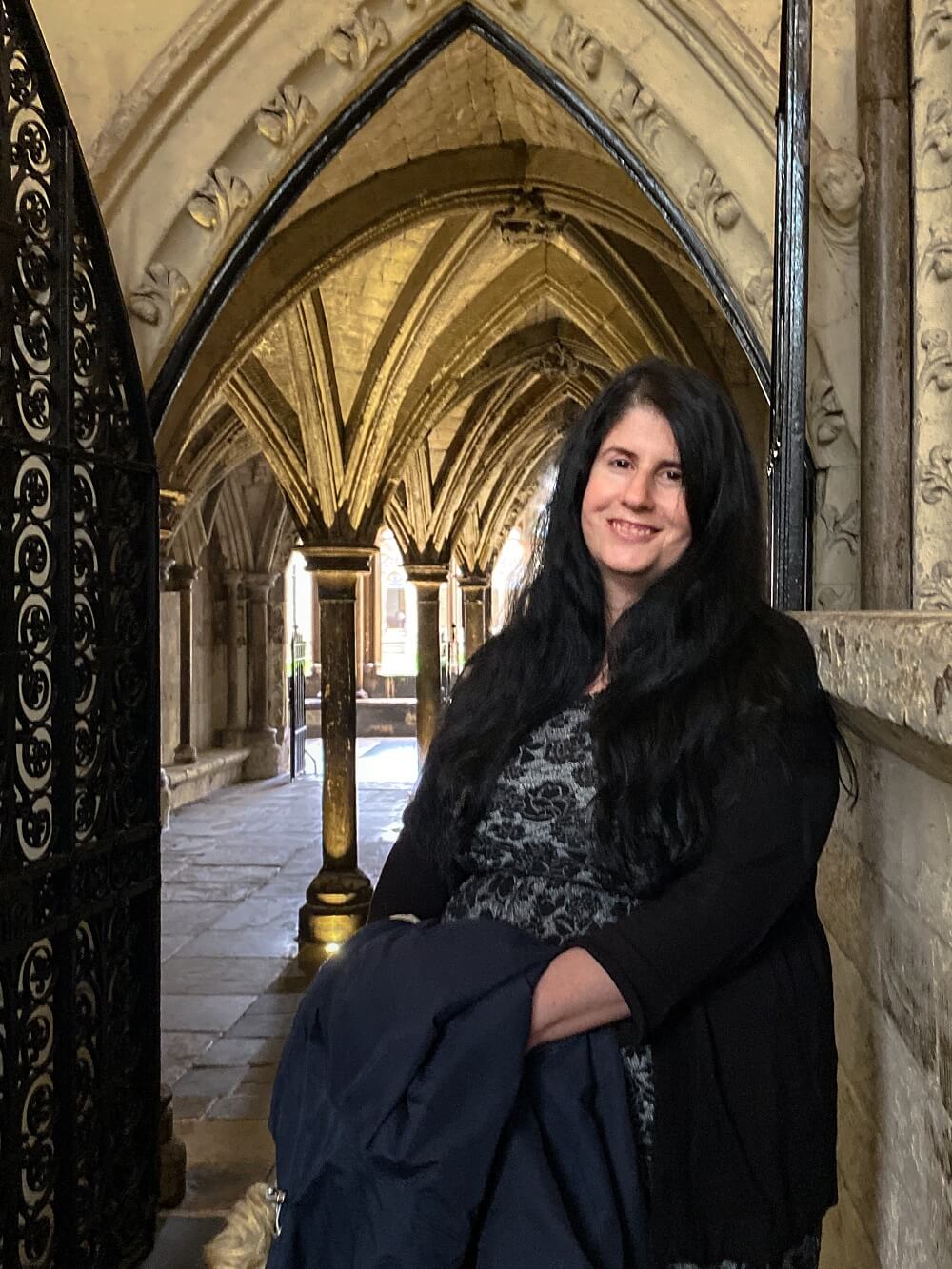
Westminster Abbey Hours
Westminster Abbey is a working church so the hours for visitors are limited. It’s best to check on the website for the date of your visit.
Keep in mind the Abbey is always closed for visitors on Sundays. The Abbey Gardens are only open Tuesday through Thursday.
Westminster Abbey Admission
Regular admission to Westminster Abbey costs £21 for adults and £9 for children. If you want to do one of the guided tours, it’s an additional fee of £7. Admission to the Queen’s Galleries is also an additional fee of £5.
Buy your tickets here in advance, it will be a few pounds more if you wait and buy them when you get to the Abbey.
How to Save on Westminster Abbey Admission
It is possible to save money when visiting Westminster Abbey, you just need to be a bit strategic. Consider adjusting the time of your visit or purchase a London sightseeing pass.
Wednesday Lates
To save money at Westminster Abbey consider visiting during “Wednesday Lates.” Admission is half-price on Wednesdays from 4:30 pm to 6:00 pm. The multimedia tour is not available during this time, but that shouldn’t be a concern as you can use the Westminster Abbey App instead. You will also not be able to go to the Queen’s Galleries, the Quire, or the High Altar.
Since the Abbey is only open for a few hours for Wednesday Lates, you will need to make the most of the limited time. I would recommend arriving a little early so that you will be one of the first to enter. Also, buy tickets in advance to skip the line after going through security.
Tickets to see Westminster Abbey during Wednesday Lates cost £11 for adults and £5 for children. You can purchase the tickets here.
Combined Ticket with St. Paul’s Cathedral
If you also plan on going to St. Paul’s there is a pass that you can purchase that will save you money. This pass includes admission to Westminster Abbey and St. Paul’s for a discount.
London Pass
Westminster Abbey is included as part of the London Pass. This can be an easy way to save money on your sightseeing in London because it includes 80 of London’s top attractions for one price. Some of the other London must-sees included on the pass are the Tower of London, Windsor Castle, Hampton Court Palace, Up at the O2, and Wembley Stadium Tour.
Click here to get more information on the London Pass.
How to visit Westminster Abbey for free
If you are not concerned about seeing all of Westminster Abbey but want to say that you have been inside the famous church, you can attend a service for free. You won’t be able to walk around and see the monuments but at least you can see some of the architectural highlights.
Attending a Service at Westminster Abbey
Westminster Abbey, with its rich history and grand architecture, holds daily services open to the public (check the schedule here). Despite not being religious, I was intrigued and decided to attend an evensong service. It turned out to be a truly memorable experience. Let me share a glimpse of what happened and some tips for those interested in joining a service at Westminster Abbey.
To make the most of the service, plan to arrive at least 10 minutes before it starts, but earlier is better as they start letting people in 30 minutes ahead of time. Check in with the staff at the visitor’s exit, known as the west door, and go through a security check. They’ll guide you to a line in the North Choir Aisle. Remember, no photos inside.
I went on a Wednesday, which happened to be the choir’s day off. Fifteen minutes before the service, we were seated in the Quire. If you arrive later, you’ll be directed to the Nave, which still offers a good view. They provided an electronic order of service through a QR code. The actual service lasted about 20 minutes, but it can be longer on other days with the choir present.
How to Get to Westminster Abbey
Westminster Abbey is located in Central London near the Houses of Parliament. The closest tube station is Westminster, but Victoria and St. James Park stations are also within walking distance.
You pay for your tube ride using an oyster card, contactless credit card, or Apple pay. If you are visiting from overseas, consider purchasing the Visitor Oyster Card, which can be mailed to you so you are ready to use public transportation as soon as you arrive.
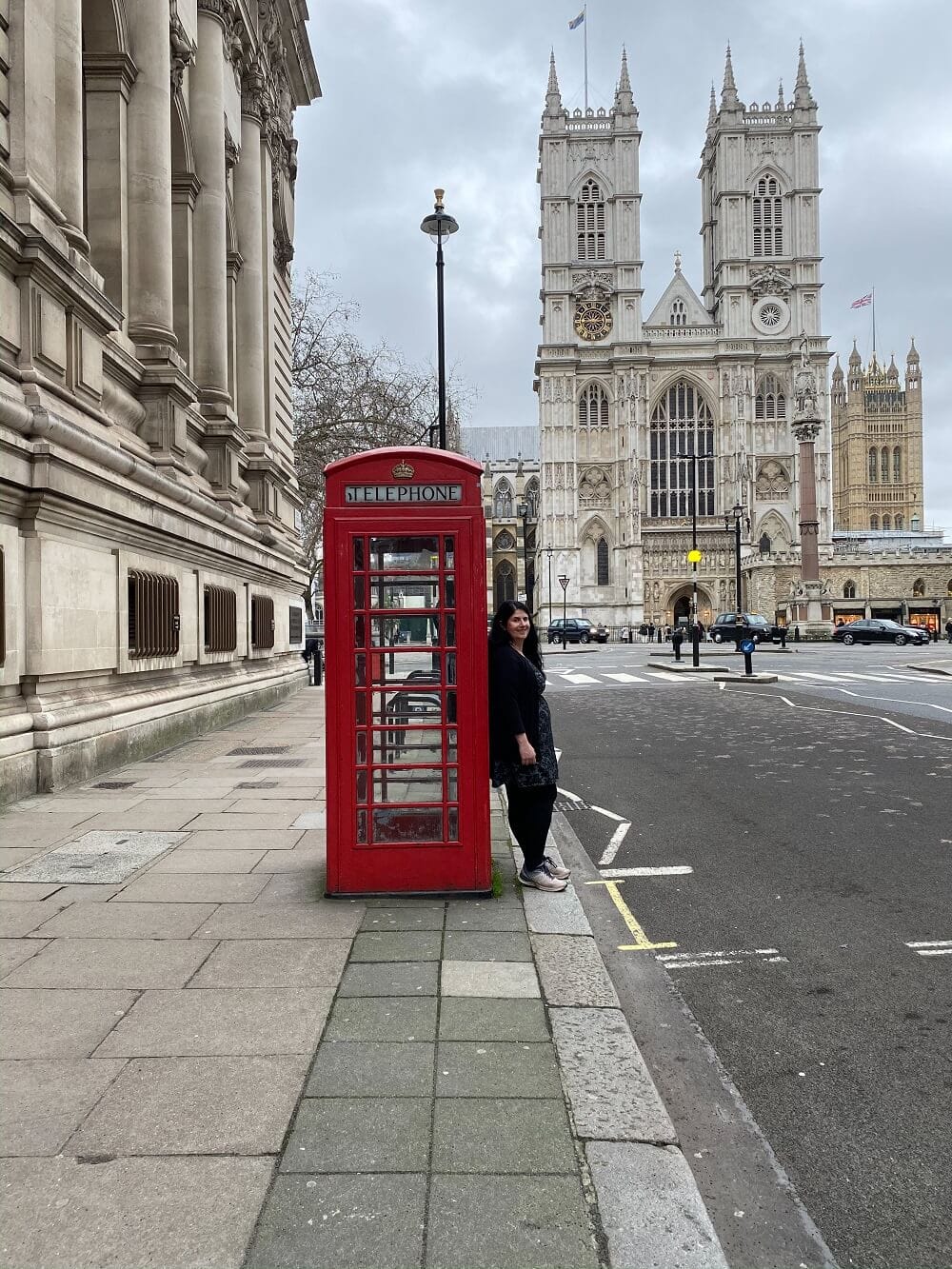
Things to Know Before Visiting Westminster Abbey
Westminster Abbey is a popular tourist attraction that is also a place of worship. There are a few things that need to be arranged before you visit.
Bags in Westminster Abbey
No backpacks or bags (other than purses) are allowed inside. There is no place to store bags at Westminster Abbey. This means you must check bags somewhere else in advance.
We used LuggageHero to store our bags. You can use the app or website to find locations that are convenient. We chose to store our bags at the Victoria Station Hotel as it offers storage 24 hours a day. It’s not the fanciest hotel, but for bag storage it is fine. They give you locks for your bags and they are insured. What I like most about LuggageHero is that you only pay for the time that the bags are stored. If you want to try LuggageHero, use the code TEXANHERO to get two free hours. Click here to make a reservation.
You can also store bags at Charing Cross or Victoria train stations but it will be more expensive. While you don’t need a reservation to store bags at the station, you will get priority service if you do. Click here to get more information.
Westminster Abbey App
Download the Westminster Abbey App here. It has the same information as the audio tour. You have to turn in the audio tour after Poet’s Corner, but you can keep listening to the app even after your visit. In addition to downloading the app, set up the offline mode before your visit. I wish I had as I had some difficulty with the lack of data service. You can find the option in the hamburger menu on the top left of the app.
Dress Code
Wondering what to wear? While there is no official dress code for Westminster Abbey, they ask that you dress respectfully and men remove hats. It can be a bit chilly inside the Abbey during the winter months so bring your jacket. Additionally, the floor is uneven in places, so please wear practical shoes (i.e. no stilettos).
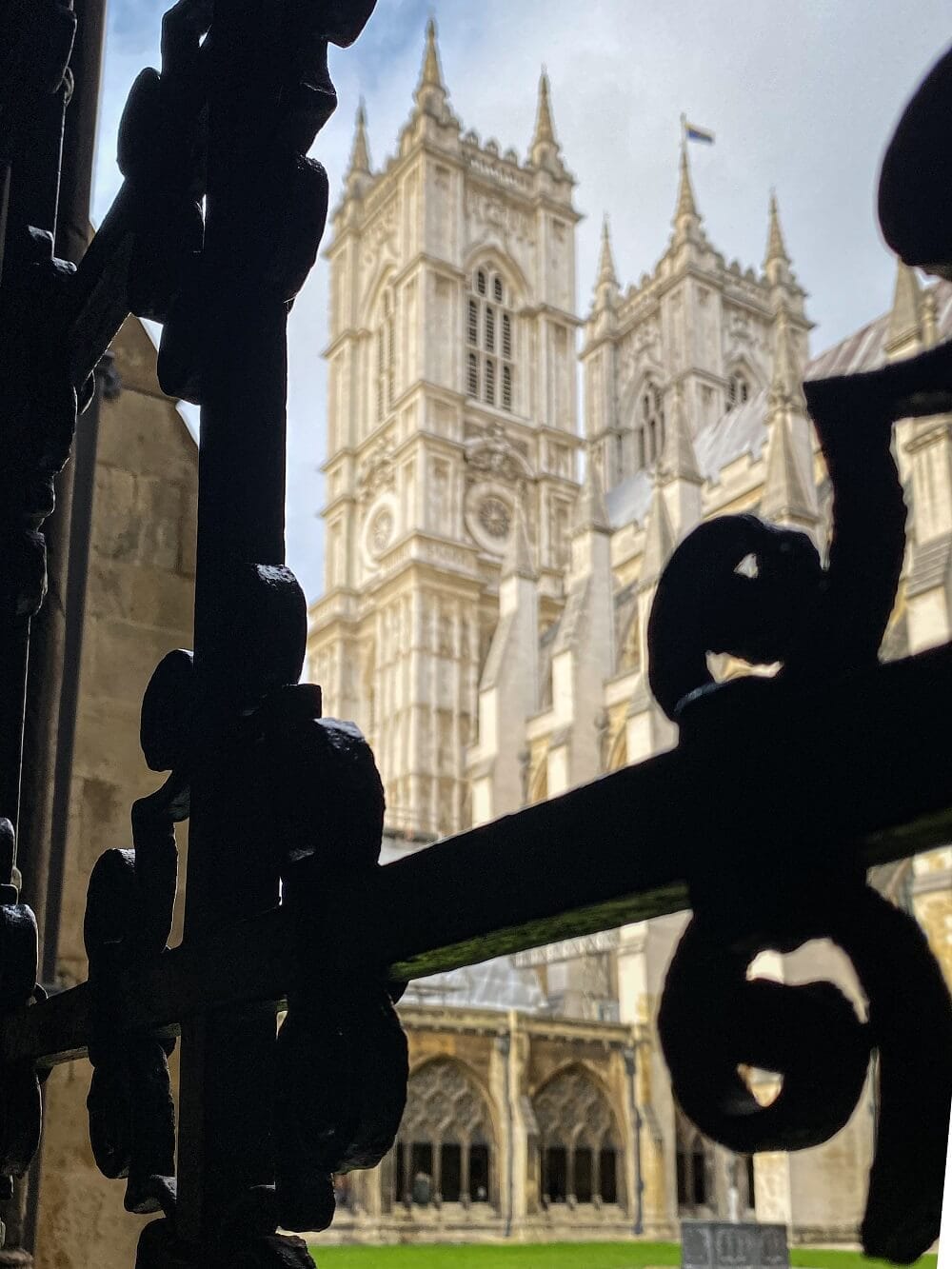
Is Westminster Abbey Accessible?
Due to its historic nature, there are some parts of the Abbey that are not accessible to those that have mobility issues. Those visitors and their carers get free admission and need to enter the Abbey through the North Door.
The Abbey has special tours for visually-impaired visitors and those with hearing difficulties. They also allow you to bring guide dogs, hearing dogs, and assistance dogs.
Get more information about disabled access at the Abbey here.
How Long Does it Take to Visit Westminster Abbey?
It depends on how many plaques you want to read. We spent a little more than three hours inside, but there were a few memorials that we still missed and we rushed through the Queen’s Galleries. If you are tight on time and want to see as much of the Abbey as possible then it might be best to do the guided tour.
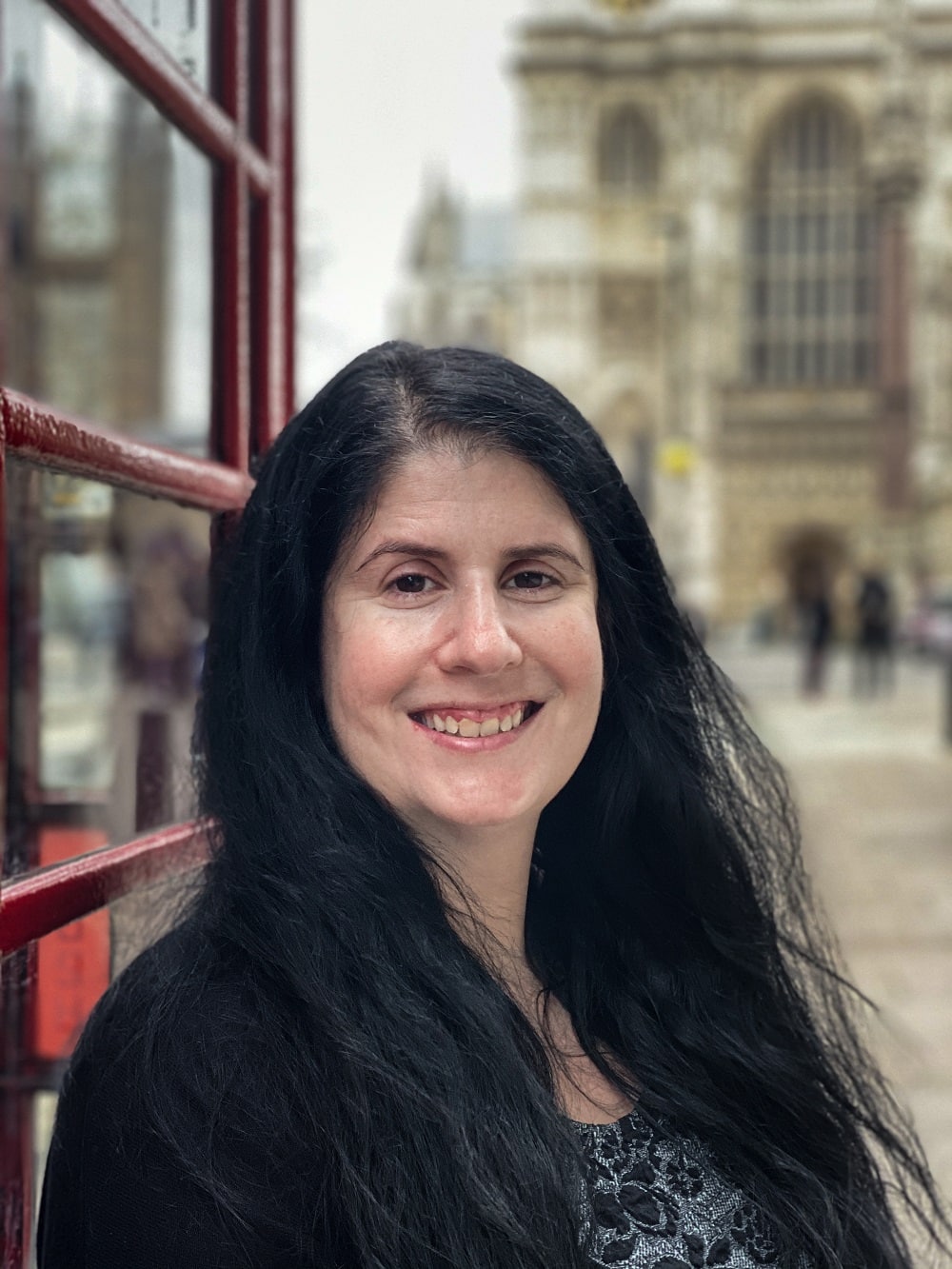
Is Westminster Abbey Good for Kids?
Children are welcome at Westminster Abbey. Keep in mind it is a place of worship so they need to be respectful. They have a booklet called the Children’s Trail, which is available by the entrance for free, to make the visit more interesting for them.
At the Cellarium, they offer one free meal from the kids’ menu with every adult main meal that is purchased. They also have a free coloring sheet to help keep the kids entertained.
Should You Do a Guided Tour of Westminster Abbey?
If we were to visit again I think I would pay extra for the guided tour. At Westminster Abbey, these tours are led by vergers, who are not part of the clergy but assist in the ordering of religious services. They know the history and traditions of Westminster Abbey better than anyone.
During our visit, we ran into the guided tour a few times and I overhead a bit. They were definitely getting more inside information than what was provided in the audio tour. Additionally, guided tours get to go into Edward the Confessor Shrine.
I think it would be worth the £7 charge for the tour. (Note: You have to pay admission to Westminster Abbey too). Space on the guided tours is limited to 20 people and commentary is in English only. It lasts about 90 minutes. They only offer a few tours per day, the schedule varies depending on the time of year and day.
You cannot purchase tickets for these verger tours in advance, they must be booked upon arrival at Westminster Abbey.
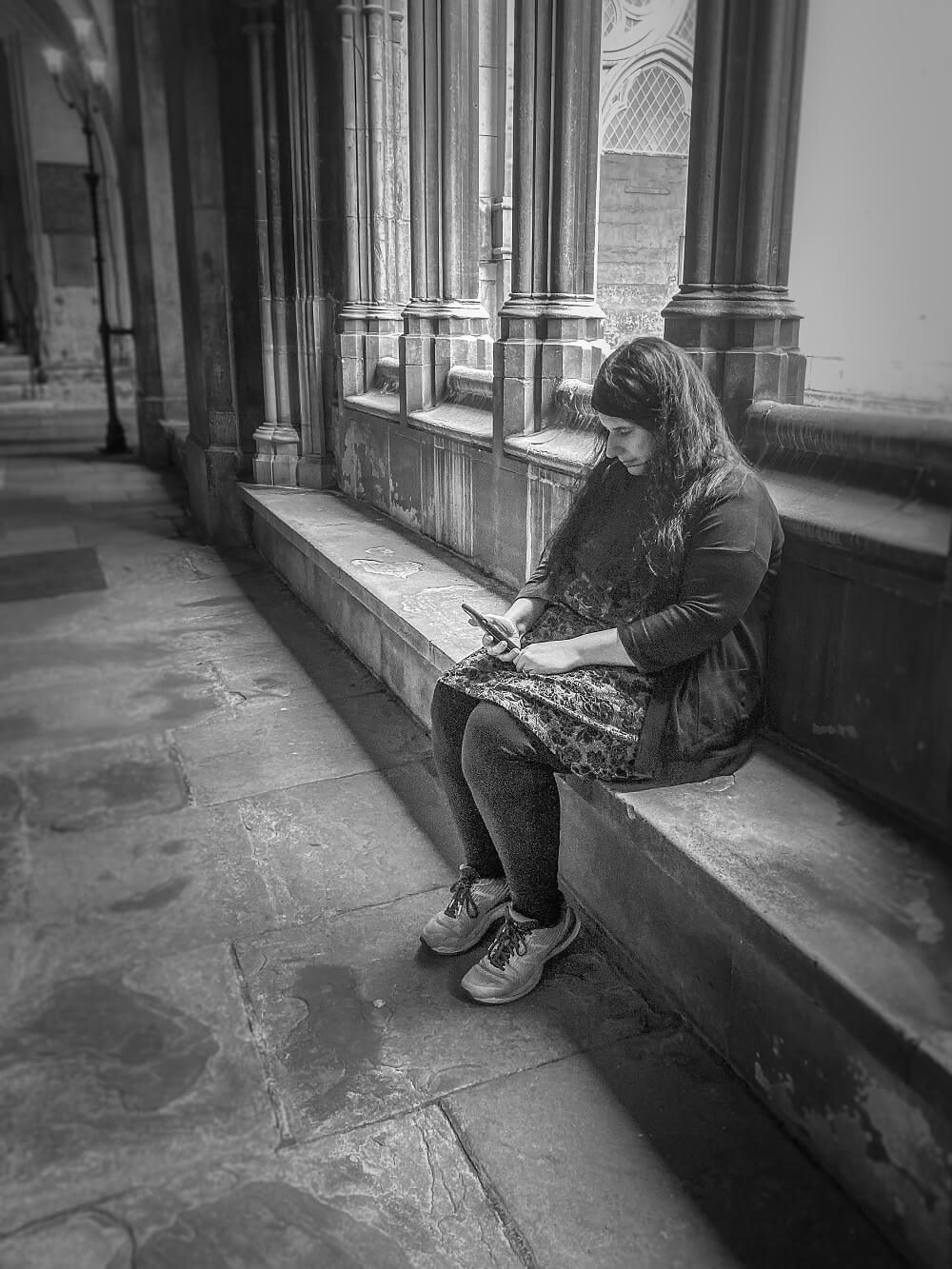
Other Tourist Attractions Near Westminster Abbey
If you have a whole day to go sightseeing in the area there are several other attractions nearby:
- Parliament Square is just to the north of Westminster Abbey. Walk around and see the 12 statues of British and international political figures.
- Houses of Parliament/Big Ben are located to the east of the Abbey. You can tour the Houses of Parliament. Unfortunately, Big Ben is under renovation. If you want to visit both Westminster Abbey and the Houses of Parliament, consider taking this exclusive guided small group tour.
- Jewel Tower is around the corner from Westminster Abbey. It was built around 1365 to house Edward III’s treasures and was known as the ‘King’s Privy Wardrobe’. It is an English Heritage site, so English Heritage members or those that buy the English Heritage visitor’s pass can visit for free.
- London Eye is the large Ferris wheel with panoramic views across the Thames.
Is Visiting Westminster Abbey Worth it?
Yes. I was surprised by how much there is to see inside the Abbey. The history is awe-inspiring and will leave you wanting to learn more. It is amazing to think about all the important events that have taken place here from coronations to ceremonies, to weddings, to funerals over the years. I am not sure there is anywhere else where you can see graves and memorials to so many influential people.
Since it’s an indoor attraction, it can be a smart way to escape the bad weather in London during the winter. Even on a nice day, you won’t mind spending time inside the Abbey.
Don’t let the price tag put you off. I can understand why they charge to go inside this church as I can only imagine the upkeep costs. It is a UNESCO World Heritage site for good reason!
Have you been to Westminster Abbey?
-Anisa
If you found this post helpful, you can join our email community here or follow the blog on Bloglovin here.
Expert Tips for Visiting Westminster Abbey
- Don’t bring any backpacks or bags other than purses. Use LuggageHero to store them in advance.
- Download the Westminster Abbey app in advance here.
- Save money on your visit by either buying tickets in advance, taking advantage of Wednesday Lates, or by purchasing the London Pass.
Disclosure: Thanks to Westminster Abbey for providing complimentary tickets so that we could share our experience with our readers. All opinions are our own.
This post also contains affiliate links. This means we will receive a small commission for some purchases made using links in our blog with no additional cost to you. Please be assured we would not promote any product unless we believe that our readers will also benefit. The commission does not influence the editorial content of this site.
Last Updated on June 14, 2023

